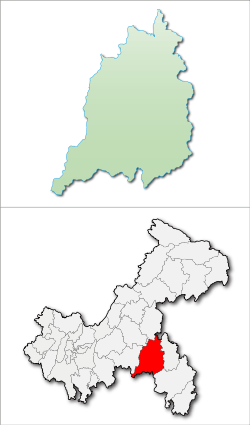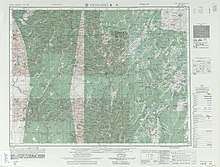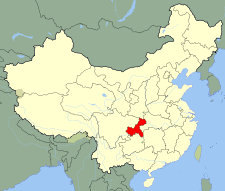Pengshui Miao and Tujia Autonomous County
Pengshui Miao and Tujia Autonomous County (Chinese: 彭水苗族土家族自治县; pinyin: Péngshuǐ Miáozú Tǔjiāzúzìzhìxiàn) is located in southeastern Chongqing, China, bordering Guizhou province to the south and southwest and Hubei province to the northeast. It is 270 kilometres away from Downtown Chongqing.
- Area: 3,903 km2 (1,507 sq mi)
- Population: 622,200 (2001)
- County seat: 201 Beimen Jie, Hanjia (汉葭镇北门街201号)
- Geographic coordinates: 28°57′ – 29° 51′ North, 107°48′ – 108°36′ East
- Altitude of the seat: 245 m (804 ft)
Pengshui 彭水县 | |
|---|---|
Autonomous County | |
彭水苗族土家族自治县 Pengshui Miao and Tujia Autonomous County | |

| |
 Location of Pengshui County in Chongqing | |
| Country | People's Republic of China |
| Municipality | Chongqing |
| Area | |
| • Total | 3,903 km2 (1,507 sq mi) |
| Population (2010) | |
| • Total | 545,100 |
| • Density | 140/km2 (360/sq mi) |
| Time zone | UTC+8 (China Standard) |
Geography

It is at the lower reach of Wu Jiang and in the mountainous region of Wuling. 27.3% of Pengshui is covered by forest.
Neighbours:
- North: Shizhu Tujia Autonomous County
- Northeast: Lichuan City, Enshi Tujia and Miao Autonomous Prefecture, Hubei
- East: Qianjiang District
- Southeast: Youyang Tujia and Miao Autonomous County
- South: Yanhe Tujia Autonomous County, Guizhou; Wuchuan Gelao and Miao Autonomous County
- Southwest: Daozhen Gelao and Miao Autonomous County, Guizhou
- West: Wulong County
- Northwest: Fengdu County
Demographics
59.5% of Pengshui residents are members of the following 11 ethnic minorities: Miao, Tujia, Mongols, Hui, Gelao, Dong, Tibetans, Manchus, Zhuang, Yi, and Hani. There are 270,000 Miao and 90,000 Tujia in Pengshui.
History
In 593 (Sui Dynasty), Pengshui District (縣) was established. "Pengshui" means "Peng River", and was the old name for the Yu River (郁江). By 1645 during the Qing Dynasty, it was part of Chongqing Prefecture (重慶府). In 1913 (Republic of China), it was part of Dongchuan Circuit (東川道). In 1927, it was reassigned to Changgong Bureau (長公署) of Sichuan Province. And in 1935, of the Eighth Administrative Inspection Area (第八行政督察區) of Sichuan.
On November 16, 1949, Pengshui was captured by the communists. In January 1950, it was part of Fuling Special District of Chuandong administrative territory (川東行署涪陵專區). In September 1952, Fuling Special District was transferred to Sichuan, and was changed to a prefecture in June 1968.
The autonomous county status was approved by the State Council on November 14, 1983. The official status began November 10 of the following year. In 1987, it was assigned to Qianjiang Prefecture. In June 1997, it was directly governed by Chongqing Municipality.
Subdivisions
10 towns and 29 townships, which contain 602 villages, 41 neighborhood committees and 4902 village committees (see Administrative divisions of the People's Republic of China#Levels).
Towns:
- Hanjia (漢葭鎮)
- Gaogu (高穀鎮)
- Yushan (鬱山鎮)
- Baojia (保家鎮)
- Huangjia (黃家鎮)
- Lujiao (鹿角鎮)
- Sangzhe (桑柘鎮)
- Puzi (普子鎮)
- Longshe (龍射鎮)
- Lianhu (連湖鎮)
Townships:
- Dianshui (靛水鄉)
- Qiaozi (喬梓鄉)
- Luming (鹿鳴鄉)
- Xintian (新田鄉)
- Anzi (鞍子鄉)
- Runxi (潤溪鄉)
- Changtan (長灘鄉)
- Zhufo (諸佛鄉)
- Litang (棣棠鄉)
- Xiaochang (小廠鄉)
- Meiziya (梅子埡鄉)
- Wanzu (萬足鄉)
- Shipan (石盤鄉)
- Shuanglong (雙龍鄉)
- Daya (大埡鄉)
- Shiliu (石柳鄉)
- Sanyi (三義鄉)
- Ping'an (平安鄉)
- Lutang (蘆塘鄉)
- Zouma (走馬鄉)
- Longxi (龍溪鄉)
- Shangan (善感鄉)
- Langxi (朗溪鄉)
- Longtang (龍塘鄉)
- Lianhe (聯合鄉)
- Qianqiao (遷喬鄉)
- Taiyuan (太原鄉)
- Tonglou (桐樓鄉)
- Yandong (岩東鄉)
References
External links
- Official site
- Gongtan village Newspaper report on property confiscation in Pengshui Miao and Tujia Autonomous County

